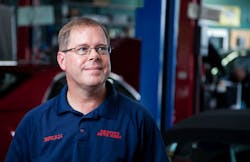It wasn’t until one day when Brian Jesko, owner of Trinity Auto Haus in Waco, Texas, was attending a service advising course that he realized not every shop owner in the classroom worked 90 hours per week. Nor did they work six days per week or spend most nights at the shop, like he did.
Looking around, it occurred to Jesko that because of all the hard work he had put in owning a shop, most of his life was passing by. One of his children had already moved out and the second only had a few years left in the house.
“Where had those years gone?” he wondered.
In that class, he heard a constant refrain from several coaches and fellow shop owners: “You’re making money. You’re doing OK. You just don’t have a life.” Hearing that made Jesko realize that the problem was obvious to other people, as well.
Jesko worked hard to get his $1.5 million business to where it is today, but the problem wasn’t working hard—it was working too much. He realized that his work-life balance needed to be evaluated before he wound up running himself into the ground.
The Backstory
Jesko has been turning wrenches since 1991, when he was 19 years old. But it wasn’t until 2011 when the seasoned technician turned into a shop owner.
Jesko started the company with his then-business partner, who he eventually bought out in 2013. In that first full year, the shop generated $654,000 in annual revenue. In only a few years, he’s grown that revenue to $1.5 million.
With a monthly car count of 240, his business was thriving in his area, but he slowly realized that the more work he signed up for, the more overwhelmed the shop became.
It didn’t help that he was still working on cars at the time, so the responsibilities of fixing cars, managing a staff and taking care of business operations grew each day.
The Problem
Working 80–90 hours over six days per week began to negatively impact Jesko’s life. He realized that the more he tried to grow the business and move it forward, the more problems he created for himself and his personal life.
Jesko always had borderline workaholic tendencies, even during his time as a technician, but after becoming a shop owner, the problem got worse. He slowly found himself coming in earlier in the morning and leaving later at night. For Jesko, that meant arriving before 7 a.m. and not leaving until sometimes after 10 p.m.
Lack of rest and a worsening attitude left him worn out and a different person mentally, he says.
“I was so focused on business that I forgot that I had a wife and two kids,” he says.
The root problem had to do with his mindset: Because Jensko was so focused on growing his business, he ended up taking all the work he could get. For every phone call he took, he had the same response: “Yes, bring it in.”
“I think a lot of times we don’t realize it’s [overworking] happening because we think we go into it thinking we’re doing the right thing. I thought I was doing the right thing,” he says.
The Solution
Jesko’s first course of action was to hire a coach. In November 2015, he hired Cecil Bullard, CEO of the Institute for Automotive Business Excellence, who visited Jesko’s shop twice for several days at a time. BJ Lee, vice president of the Institute, also visited the shop to evaluate the obstacles that hindered Jesko’s ability to strike a better work-life balance.
After observing the shop, Bullard, Lee and Jesko implemented a number of changes and processes that would help him become a true shop owner versus a technician:
Establish a staff of leaders. One of the keys was building a support system in the shop. Bullard helped Jesko find a standout tech in his shop who had the ability to run it while he was not there.
But it wasn’t just about just training one leader, it was about training the team as a whole and making sure everyone in the shop had management training.
Jesko says this was important because whether they were managers or not, they needed to possess managerial skills. In particular, the training was critical for the service advisors because of their heavy involvement with customers and techs.
This change did have its obstacles in the initial stages. Jesko had to create a team that was loyal and eventually realized that some employees were doing more harm than good. One technician, in particular, had such a bad attitude that Jesko couldn’t even see the issues the tech caused until he was let go. He ended up replacing two technicians and one service advisor.
Although it was hard for Jesko, it was the first step to creating a team of leaders that allowed him to step back.
“Right now, I have a team of people that work for me or work with me that I think any shop owner out there would be jealous to have,” he says. “I’m the luckiest shop owner in the world because I’ve got the best crew.”
Allow only a certain amount of hours in the office. Bullard advised Jesko to only allot a certain amount of time in the office. This started by not being a technician anymore. Because Jesko was working on cars, he would come in late in the evenings or on Saturdays so he could catch up on paperwork.
Now, he dedicates his mornings to completing paperwork and then that leaves him time to check in on his team, run any errands, and get involved with his local chamber and Rotary Club or any other events where he can go out and sell his business.
Don’t say yes to every job. Jesko thought that the more cars he serviced, the more money he would make. But, as Bullard explained, if your shop isn’t equipped to handle that volume of work, accepting all jobs that walk through the door will only create headaches.
In Jesko’s case, he was taking in 65–70 cars per week, all while expecting his three technicians not to burn out. He admits he was expecting too much. Now, the shop doesn’t take restorations anymore and service advisors ask more questions during that initial phone call instead of just saying yes.
Jesko says that the shop’s sweet spot is about 17 cars per week per tech. That way, the techs are able to go home happy and stress free.
The Aftermath
Since creating a shop environment that can sustain itself and establishing a more consistent work schedule, Jesko can enjoy some time to himself.
Although he is still working on achieving that perfect balancing act and says it’s a nonstop effort to be mindful of when it’s time to call it quits and go home, he is now held accountable for keeping it up by his wife and Bullard.
Work-life balance is not just about the ability to enjoy oneself, but also the ability to recoup from a long workweek.
“Getting that balance back makes me a better person when Monday hits,” he says. “My attitude being better spreads across the board to everybody else.”
The Takeaway
Jesko attributes a great deal of his success in finding a better balance to the support system he has built, something he says is necessary to understanding the problems in your shop and how to fix them.
And as someone with no ownership experience prior to owning his shop, he says reaching out and finding help is essential. He believes finding someone like Bullard can be of tremendous help in not only giving advice, but also coming in and showing how to fix problems. This ensures that someone holds you accountable to your commitment to change, Jesko says.
“I’ve surrounded myself with very successful people [and that] was the best thing for me,” he says.

